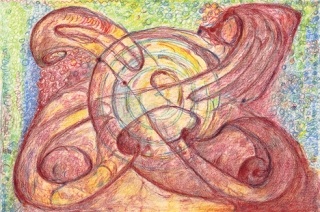Dementia is as cruel a disease as any, robbing its victims of their memories of a life lived, the ability to communicate as easily as they once did and a lucidity that quiets the mind with contemplation.
One local artist has used her artistic prowess to battle the ogre of Alzheimer’s and a new body of work has emerged from that fight.
In December 2001, the prolific 2D artist Sarah Wallace was diagnosed with Alzheimer’s disease.
Wallace’s husband, Ivan Neaigus, took on the task of being her primary caregiver, and together they began to deal with the challenge of life as it had changed and would always be.
Wallace was born in La Jolla, Calif. where her childhood and formative years were immersed in the Southern California environment.
Her ongoing love of the ocean and her ardent beachcombing contributed to the expansive collection of rocks, shells, driftwood and beach paraphernalia that would eventually show up in her substantial body of drawings, paintings and photos she made through her lifetime.
The couple moved to Whidbey Island in 1984, where they both stayed active in the arts community.
In 1994, Wallace won first prize at the Choochokam Festival of the Arts, participated in various gallery shows and for years was on the Whidbey Island Open Studio Tour, along with her sculptor husband.
Having discovered the studies of Cameron J. Camp, a psychologist and senior research scientist at Myers Research Institute in Ohio, and having been faced with the challenge of keeping his wife active, Neaigus re-organized Wallace’s studio into a shared working space in 2006.
According to the Camp studies, persons with dementia need cognitive stimulation, along with opportunities to successfully and meaningfully interact with their physical and social environments on a regular basis.
Camp’s ideas are influenced by what the innovative educator Maria Montessori aimed to do with early childhood education.
Montessori thought children should be seen as competent beings who should be encouraged to make maximal decisions while performing the tasks of practical living and the activities that engage them.
Excited that he finally was given something constructive to do for his wife, Neaigus prepared colored pencils and created some geometric shapes on paper to get Wallace started.
So began Wallace’s journey into a new period of her art entitled “Transitions.”
Unlike her previous work of stylized realism, her new work is abstract.
Wallace’s natural artistic intuition is revealed through the intricate use of colors and composition in her new work.
With the help of her husband and the use of curved templates, a compass and rulers to outline a geometric image, Wallace plunges into the faintly drawn image and continues its development freehandedly.
Neaigus said he is happy to have found the teachings of Camp when he did.
“Because of her disease, she’s in a sort of no-mind meditative state,” Neaigus said.
“It’s a perfect mind for getting in touch with the gut.”
Not only has Wallace continued to be active in her life as an artist, her husband said she is better off now than when she was first diagnosed with Alzheimer’s seven years ago.
“Her well-being is much better now because of what we’ve discovered,” Neaigus said.
Neaigus believes the teachings of Camp could be of great use for anyone of any profession dealing with Alzheimer’s.
“What I noticed in the beginning was that people were waiting for that magic wand to fix everything, rather than dealing with the matter at hand,” he said.
It would be great, Neaigus said, if researchers do find a cure for Alzheimer’s, but meanwhile families must learn how to deal with it actively day-to-day.
The studio has become a refuge space for Wallace, Neaigus said, and is making a major impact on her life.
The Camp studies show that many of the problems associated with dementia can be traced to the inability to create the sense of accomplishment that patients need.
In his manual “Montessori-Based Activities for Persons with Dementia,” Camp provides stimulating, interesting and challenging activities to help people with dementia.
Wallace is also an avid participant at “Time Together,” a respite program at the Bayview Senior Center in Langley.
Neaigus said he feels lucky to live in a community such as his, and that the senior center program has helped tremendously in giving Wallace a social connection, while he is able to benefit from the program’s caregivers group.
Wallace’s profligacy is proof that her activity-based life is beneficial. Wallace has completed 31 works for the “Transition” series, which can be viewed along with some of her previous work;Click here. Several pieces are also currently on display at the U.S. Bank in downtown Langley until early January.
The “Transition” works are being reproduced as giclee prints, and will be offered for sale in unlimited editions through Fine Balance Imaging Studios in Langley.
Ten percent of proceeds will be given to the Time Together program, and
10 percent to Alzheimer’s research.
Patricia Duff can be reached at 221-5300 or pduff@southwhidbeyrecord.com.


